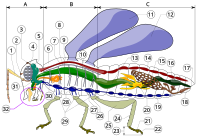
Photo from wikipedia
Abstract The morphology of Zn deposit can be controlled by pulse deposition. Using defined pulse parameters (20 millisecond-on and 80 millisecond-off), the deposition current density was examined in 50–200 mA cm−2, in… Click to show full abstract
Abstract The morphology of Zn deposit can be controlled by pulse deposition. Using defined pulse parameters (20 millisecond-on and 80 millisecond-off), the deposition current density was examined in 50–200 mA cm−2, in the electrolyte 9 M KOH + 5wt% ZnO, at room temperature (approximately 20 °C) on a Zn plate. The obtained Zn morphology is a well-compact boulder microstructure below 100 mA cm−2. The coulombic efficiency of the deposition is close to 100%. The obtained Zn deposit shows over 90% packing density, with good adhesion to the Zn plate. A change in Zn morphology with deposition time is also observed. The compact boulder microstructure form in the 1 h deposition time becomes a granular spongy Zn after 5 h of deposition.
Journal Title: Journal of energy storage
Year Published: 2019
Link to full text (if available)
Share on Social Media: Sign Up to like & get
recommendations!